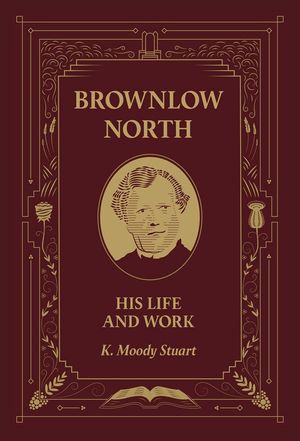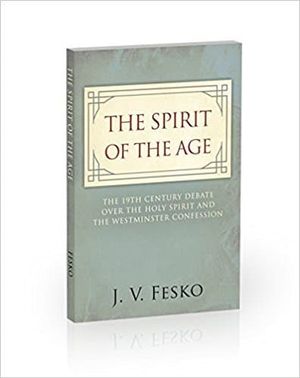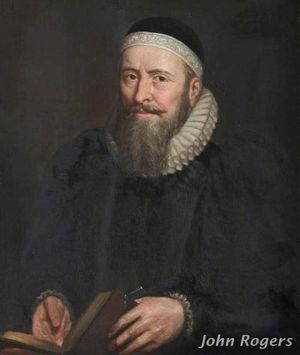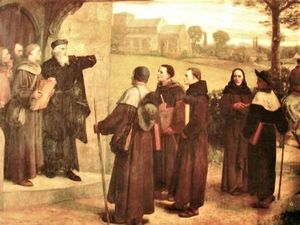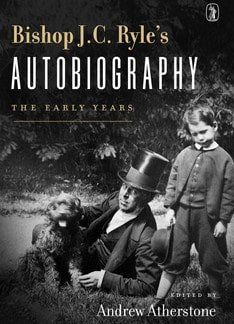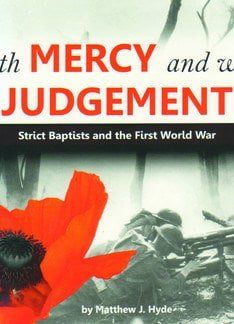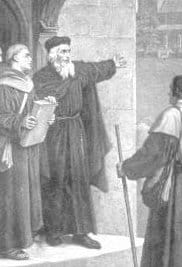
Six hundred years ago, on 2 March 1401, William Sawtry was burned at the stake in London. As the first martyr to be burned under the notorious act, de haeretico comburendo, Sawtry was the first of the noble company who did for the gospel in Smithfield. Much more is known of some who later suffered there, and Sawtry is a somewhat shadowy figure. But he should be remembered as a pioneer.
The Lollards
William Sawtry was a Lollard, that is, a follower of John Wyclif, often called the ‘Morning Star of the English Reformation’. Although Wyclif had been dead for over sixteen years by the time Sawtry was martyred, his influence remained, an enduring challenge to the teachings of the Roman hierarchy.
During a distinguished university career at Oxford, Wyclif progressed from attacking the worldliness of the medieval church, to an assault on some of its fundamental teachings. Hand-written copies of his prolific writings were disseminated widely at home and abroad.
By 1378 he was teaching that any Christian can learn and understand the Scriptures. In the following year he publicly rejected the doctrine of transubstantiation, striking at the sacramental system of the medieval church.
Wyclif’s friends spread his teachings. About the year 1380 they took the momentous decision to translate the Bible from Latin into English. Their first effort was somewhat wooden, but was followed by a much improved version about ten years after Wyclif’s death.
Peasants’ Revolt
Wyclif himself was condemned by Pope Gregory XI in 1377, but was protected by powerful friends at court. His opponents eventually forced him out of his position at Oxford, but he remained rector of Lutterworth and made that little Leicestershire town the centre of his operations.
His followers were nicknamed Lollards, originally a term of abuse. For many years they enjoyed the protection of certain knights and lesser landowners. By the mid 1380s the Lollards were causing serious concern to the bishops, who were issuing injunctions against them. Although Wyclif’s teachings had been condemned at a Council in London in 1382, he ended his days in peace at Lutterworth on 31 December 1384.
One factor that helped the Lollards spread their teachings was that Richard II (who in 1377 succeeded to the throne at the age of ten) always found himself in difficulties either with over-powerful barons or a restless populace.
He was only sixteen when discontent across the country erupted in the Peasants’ Revolt. For a short time, London was at the mercy of the peasants. The situation was calmed only by the personal bravery of the young king, who offered terms to the rebels and promised to consider their grievances.
Sadly he reneged on his promises and a cruel vengeance was exacted. Wyclif’s enemies were quick to blame him and his teaching for the revolt. There was no truth in this, although Wyclif had written against the practice of perpetual serfdom.
Thomas Arundel
The ambitions of the greater nobility continued to cause the king trouble. His political problems probably prevented him giving his undivided attention to the Lollards, and the authorities did little more than order them not to preach in churches or churchyards.
The bishops could do little more than threaten, but their proclamations and denunciations had little effect. A more savage policy was needed. The man to promote this was Thomas Arundel, successively Bishop of Ely, Archbishop of York, and Archbishop of Canterbury.
Arundel was a member of one of the great noble families, younger brother of the Earl of Arundel. Extremely wealthy (at one stage he held 117 benefices), Arundel was a man of tremendous energy and ability, and yet of terrible contradictions.
In 1394, Richard’s queen, Anne of Bohemia, died after a short illness. Arundel, then Archbishop of York, conducted her funeral in Westminster Abbey. He commended the late Queen for studying the Bible in English, and said she had sent him copies of the Gospels in English, which he had approved. These comments are surprising, as the manuscripts were undoubtedly a Lollard translation. In 1396 he was translated to Canterbury.
Betrayed
In January 1397 he led the bishops in petitioning the king and Parliament to make the penalty for heresy death by burning, with total confiscation of goods, bringing English practice into line with that of other countries.
But within a few months the Archbishop himself was in serious trouble. On the orders of Richard II, both the Archbishop and his brother the Earl of Arundel, were impeached as traitors by Parliament. The Earl was executed on Tower Hill and the Archbishop was exiled.
A year later Richard exiled his ambitious cousin, Henry Bolingbroke on suspicion of treason. Bolingbroke had a considerable following in England, as well as being heir to the greatest estates in the land.
In Paris, he and Arundel met and joined forces. While Richard was dealing with trouble in Ireland they returned. They gathered a superior force, and the king was betrayed into their hands.
He was taken to the Tower of London, where he was forced to abdicate in favour of Bolingbroke who was crowned king as Henry IV by Arundel. Richard died early the following year, a prisoner in Pontefract Castle.
Although Henry reigned for fourteen years he was widely hated as a usurper. The price for Arundel’s support was the enactment of the vile law de haeretico comburendo. This act, though lacking any proper definition of heresy, authorised the bishops to try those accused and, if found guilty, ‘them, before the people, in a high place cause to be burnt, that such punishment may strike fear to the minds of others’. The Archbishop had his eye on William Sawtry and was quick to pounce.
William Sawtry
Sawtry first appears as a priest in Lynn and Tilney, in the Fens. In April 1399 he was brought before the Bishop of Norwich, Henry Despenser. A rumbustious bishop, whose behaviour had already created problems with his own authorities, Despenser now zealously hunted down Lollards.
Sawtry was accused of denying free will, image worship, pilgrimages and the doctrine of transubstantiation. After a two-day examination he was found guilty of these charges. Given time to reflect before further action was taken, he agreed under pressure to abjure these ‘errors’. Back at Lynn, he made a public act of abjuration, taking an oath on the Gospels that he would never preach these doctrines again.
Sadly, Lollard recantations were frequent. Lewis Lupton suggested that they arose partly from the loaded questions which were put to the accused. Skilful interrogators often mixed truth with error in questions to which they demanded a ‘yes’ or ‘no’ reply.
To deny a Romish error could also imply denial of truth accepted by the accused. Further, humble people were often overwhelmed by the contrived ceremonial of the occasion, and given no help in their defence.
The old message
Sawtry, deeply contrite, made his way to London, away from the jurisdiction of Bishop Despenser. In London he was appointed parish priest of St Osyths, Walbrook, where he began to preach the message which had caused such offence in Norfolk.
He was brought before a meeting of Convocation in the chapter house of St Paul’s Cathedral, London, on 12 February 1401. Although his offence had been committed in the diocese of London, Arundel took charge of his trial.
This began on 18 February. Charges against him included assertions ‘that he will not worship the cross on which Christ suffered, but only the Christ who suffered on the cross’, and ‘that after the pronouncing of the sacramental words of the body of Christ, the bread remains … as it was before, neither does it cease to be bread’.
Sawtry defended his beliefs, but to no avail. He was pronounced a relapsed heretic, and for such there was no mercy. The recently passed act sentenced to death all who had recanted and then fallen back into heresy.
Arundel pronounced sentence on 23 February. Sawtry was handed over to the lay authorities for execution. Before that could take place one more ridiculous ceremony was essential. Sawtry the priest had to be turned back into a layman. For this lengthy charade, Arundel assembled six bishops who stripped him of priestly vestments and accoutrements and proceeded to cut his hair to remove any sign of the tonsure.
False prelates
The King was in a hurry for Sawtry ‘to be committed to the fire and in the same fire really to be burned for the detestation of his crime, and the manifest example of other Christians’. So it was that on 2 March 1401, in the presence of a great crowd of spectators, William Sawtry passed through the flames into the presence of his Saviour.
John Foxe’s comment remains pertinent: ‘Thus it may appear how kings and princes have been blinded and abused by the false prelates of the church, insomuch that they have been their slaves and butchers, to slay Christ’s poor innocent members.
‘See, therefore, what danger it is for princes not to have knowledge and understanding themselves, but to be led by other men’s eyes, and especially trusting to such guides, who, through hypocrisy, both deceive them, and, through cruelty, devour the people’.


